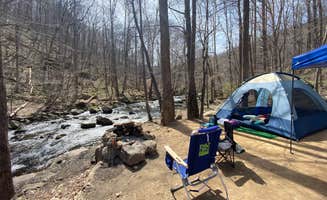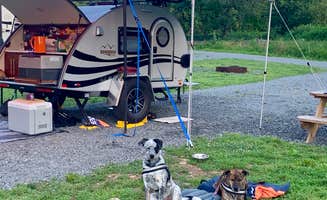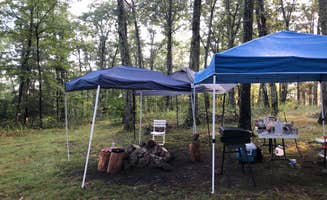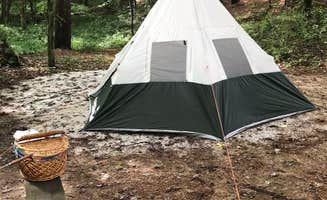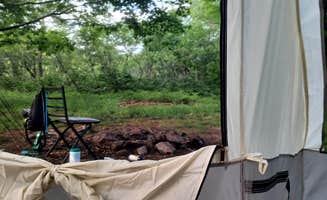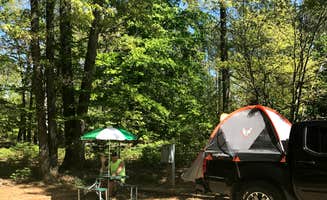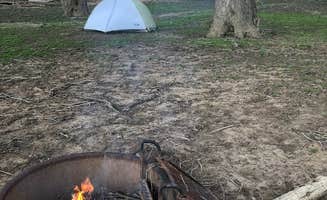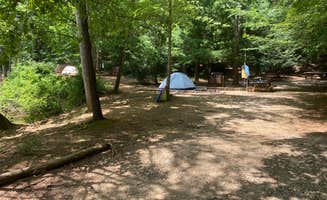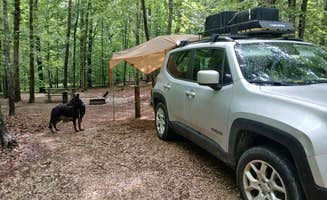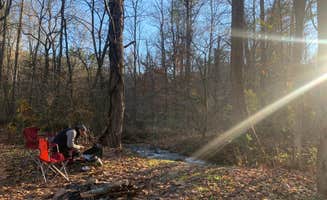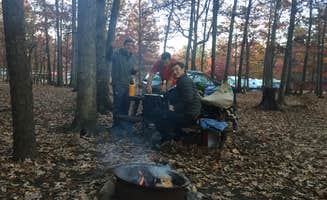Camping near Roseland, Virginia takes place in the eastern slope of the Blue Ridge Mountains with elevations ranging from 700 to 3,000 feet. Summer temperatures typically reach 85-90°F during daytime with cooler evenings dropping into the 60s. The area's unique geological features include several major waterways that provide kayaking, fishing, and swimming opportunities within walking distance of many campgrounds.
What to do
Stargazing at certified dark sky park: James River State Park's Red Oak Campground offers exceptional night sky viewing due to minimal light pollution. "The park is part of the Dark Sky Parks Association and if you're into astronomy and stars this is the place to stay. The rangers here are very interactive and very helpful. We enjoyed a fire making class followed by s'mores on Friday night and then an owl searching hike on Saturday night," notes one visitor.
Brewery tours and hiking: A unique combination available at Devils Backbone Camp where short trails lead directly to brewery facilities. "Walking distance to devils backbone brewery. Clean bathrooms. Close distance to hiking trails and other breweries and cideries. Close to humback rock, spy rock, crabtreefalls and many more trails to explore," reports a camper who appreciated the proximity to multiple outdoor activities.
Water activities on James River: Multiple access points for fishing, kayaking, and tubing. "Crystal clear water and never crowded. Both of my trips were during the summer and over a weekend and we seldom came across others. It was if we had the whole park to ourselves. My boys are excited to rent the kayaks again," explains a visitor to Red Oak Campground.
What campers like
River-adjacent tent sites: Many campers highlight sleeping near moving water as a top experience. "The sites are pretty close together so I'm sure it would be much more cramped when it's busy but it's a beautiful place. And you can fish right off the bank less than 50 yards from your tent," reports a camper at Canoe Landing Group Campsite.
Clean, modern bathroom facilities: This ranks high among camper priorities, especially for family trips. "This campground has some of the nicest facilities of any campground I've stayed at. We camped in a trailer on a site without hookups. At this time of the year, it wasn't very busy. They provide firewood on the honor system," notes a Devils Backbone visitor.
Spacious, level sites: Several campgrounds offer well-maintained camping pads. At Sherando Lake Campground, "All sites have fire rings, utility poles, and large picnic tables, and tent pads that are raked clear by campground hosts between guests," according to a review, highlighting the maintenance standards at this National Forest facility.
What you should know
Cell service variability: Coverage changes dramatically across the region. One camper at Montebello Resort notes, "The location of the campground is remote with zero cell coverage or wifi, and other than the store on-site, there isn't much outside of a few hiking trails, within 30 minutes."
Seasonal closures and limitations: Most campgrounds operate April-October with limited winter camping. "We spent five days here over Memorial Day weekend, the campsite itself is nicely wooded, has a well-supplied store with very friendly staff, a stocked trout pond, and has a nice small lake," reports a Montebello visitor, describing peak season conditions.
Varying site privacy levels: Site selection matters greatly. "The RV loops are very flat and open, with little shade or privacy between sites. They have electric hookups and drinking water available, but do not have water hookups. The tent loop is the oldest loop in this campground, and is heavily wooded," explains a Sherando Lake camper, highlighting the differences between camping areas.
Tips for camping with families
Look for integrated activities: Some campgrounds offer programming specifically for children. "The rangers here are very interactive and very helpful. We enjoyed a fire making class followed by s'mores on Friday night and then an owl searching hike on Saturday night," shares a visitor to Red Oak Campground.
Consider tent site access distance: Some campgrounds require longer walks from parking. At Oronoco Campground, "We were not prepared for the stairs. They say walk in but it's more a short hike. So getting our gear (we aren't minimalist people) in was a workout but worth it," cautions a camper.
Check for fishing opportunities: Stocked ponds provide reliable catches for young anglers. "The trout pond is a nice touch you can fish without a license, and you pay for what you catch, we enjoyed fresh trout for dinner during our stay, and from what I saw, anybody with a hook can catch one," explains a Montebello Resort visitor.
Tips from RVers
Watch hookup locations: Some campgrounds have unusual utility placement. At Devils Backbone Camp, "All the full hook up sites are pull thru and in an open field so limited shade. The hookups in this area were different than I have ever experienced as the hookups were shared between two sites. If you were on an even number site, this was no problem."
Navigate mountain roads carefully: Access to certain campgrounds requires planning. "Just went to book a site since I'm in the area, and it's a two-night minimum to tent camp. This seems crazy for a Sunday night and the campground is not at all packed. It's also $50/night, which is too high for primitive sites," notes a Devils Backbone camper.
Carry extension cords and extra hose lengths: Utility placement varies. "The sewer connection for the odd number sites is on the opposite side of the RV than the electricity and water. The good news is that in a pinch, and your sewer hose does not fit, they do have a dump station on site," advises a camper at Devils Backbone.


